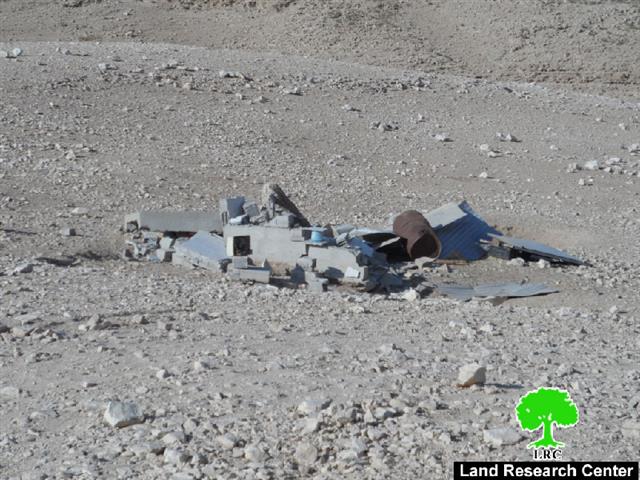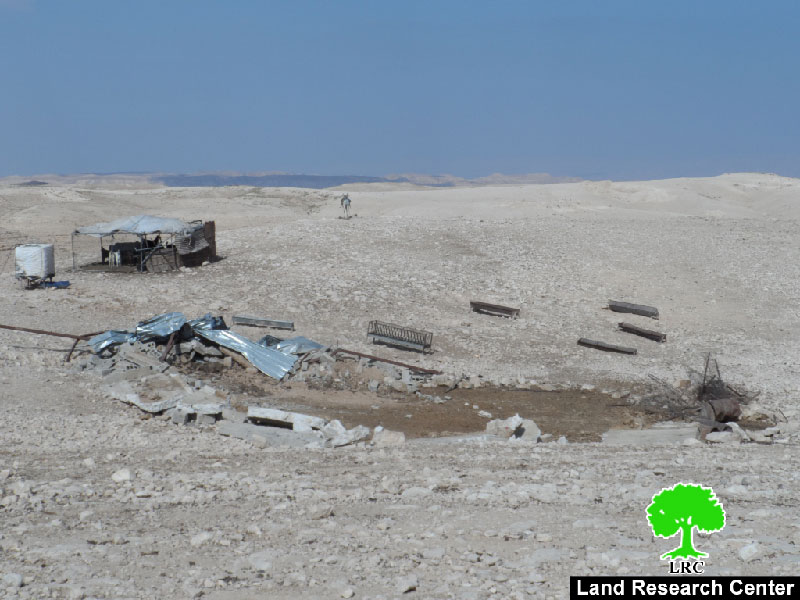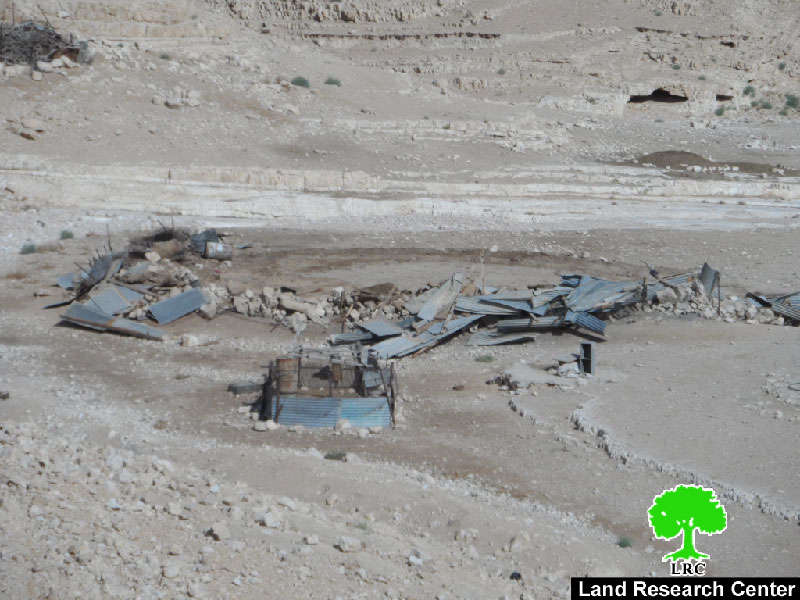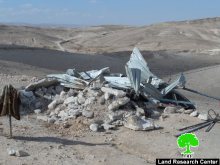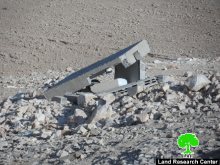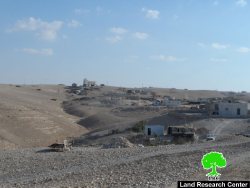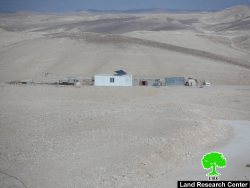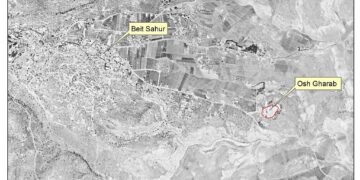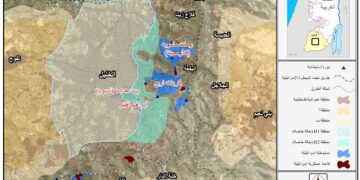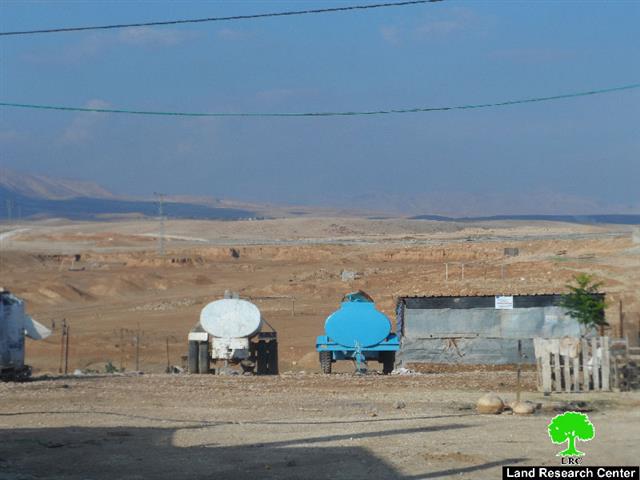Violation: destroying several facilities
Location: Yatta/ Hebron governorate
Date: 10/09/2014
Perpetrators: the Civil Administration of the Israeli occupation CA
Victims: citizens from al-Tabanih family
Details:
On 10/09/2014, the authorities of the occupation demolished residences and barns owned by citizens in Khashem ed-Daraj, southeast of Yatta in Hebron governorate.
Citizen Mustafa al-Tabanih(34) asserted that a force of the occupation and the Civil Administration with a JCB brand digger in addition to workers from a private company raided the village at 10:00 am where the workers evicted the interiors of the structures and then the digger demolished them.
Tabanih pointed out that the digger reached out three residences (made of metal slabs), barns, and livestock barracks in addition to a bathroom.
The following table explains the names of the affected citizens and structures :
|
No. |
Name |
Family |
Minors |
Area/m2 |
Structure |
Year of construction |
|
1
|
Musa al-Tabanih |
5 |
3 |
50 |
Residence of metal slabs |
2004 |
|
20 |
Residence of metal slabs |
2005 |
||||
|
120 |
A barn( fence and metal slabs) |
2004 |
||||
|
5 |
Kitchen of metal slabs |
2004 |
||||
|
2 |
Abdallah al-Tabanih |
8 |
4 |
60 |
A barn |
2010 |
|
3 |
Salama al-tabanih |
1 |
0 |
14 |
Residence( cement blocks roofed with metal slabs) |
2008 |
|
4 |
Mustafa al-Tabanih |
7 |
5 |
4 |
Bathroom (cement blocks) |
2007 |
|
5
|
Muhammad al-Tabanih |
6 |
4 |
70 |
A barn |
2008 |
|
5 |
Bathroom( cement blocks) |
2008 |
||||
|
Total |
27 |
16 |
348 |
|
|
|
Source: Field follow-up- Monitoring Israeli Violations- Land Research Center
Photos 1-6: the rubbles of the demolished structures
The chairman of the village council Ibrahim al-Hathalin stated that the authorities of the occupation destroyed the structures for them being located outside the borders of the village's master plant, which was announced in 2008. He also pointed out that the residents in 2000 worked on preparing a survey of their lands in the area to prove ownership. In 2007, the authorities of the occupation approved on giving resident an area of 2000 dunums inside the master plan; the thing that residents totally rejected hoping to get more land area than the previously suggested. By 2008, attorney Qamar Mashriqi obtained an approval on a 2500 dunuums plan.
Despite all the effort, several structures remained outside the borders of the master plan issued in 2008. Therefore, the facilities located outside the borders were notified with eviction.
About Khashim ed-Daraj:
It is situated to the southeast of Yatta town and is 20km away from it. The village has a total population of 800 people and is inhabited by several families namely( al-Tabanih, al-Hathalin, al-Faqir, and Hamadin). A roads network is there to link the village with other neighboring towns and cities. In addition to that, the town has many facilities namely (water and electricity networks, primary mixed-gender school, a clinc, a kindergarten, and three mosques).
Khashim ed-Daraj is surrounded by the natural reserve relative to Israel Nature Authority and the Dead (from the east), Um el-Khair and Arrab al-Najada (from the west), a military training camp for the occupation (from the north), and the villages of Khashim el-Karm and al-Dqiqa (from the south).
Land Research Center LRC sees that demolitions contradict with all the International conventions and Humanitarian laws including:
Article 17 of the (1948) Universal Declaration of Human Rights stating: “Everyone has the right to own property alone as well as in association with others. No one shall be arbitrarily deprived of his property.”
Section ‹G› of article 23 of the (1907) The Hague Conventions asserting: “In addition to the prohibitions provided by special Conventions, it is especially forbidden to destroy or seize the enemy's property, unless such destruction or seizure be imperatively demanded by the necessities of war.”
Article 53 of the Geneva Fourth Convention (1948) declaring: “Any destruction by the Occupying Power of real or personal property belonging individually or collectively to private persons, or to the State, or to other public authorities, or to social or cooperative organizations, is prohibited, except where such destruction is rendered absolutely necessary by military operations.”
Section 1, Article 11 of the International Covenant on Economic, Social and Cultural Rights (1966): “The States Parties to the present Covenant recognize the right of everyone to an adequate standard of living for himself and his family, including adequate food, clothing and housing, and to the continuous improvement of living conditions. The States Parties will take appropriate steps to ensure the realization of this right, recognizing to this effect the essential importance of international co-operation based on free consent."
Prepared by
The Land Research Center
LRC

